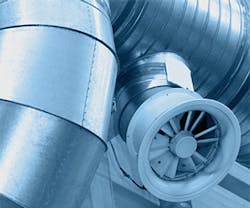If your building’s IAQ and thermal comfort are constantly fluctuating, an oversized HVAC system might be to blame. You’re not alone – about 25% of commercial HVAC systems are oversized, according to the Consortium of Energy Efficiency.
However, the statistic can be misleading because some “oversizing” is necessary – or even required by code – to meet the maximum possible load, says Jim Woods, an independent IEQ consultant and former professor of mechanical engineering.
But how big is too big?
The Dangers of Oversized
HVAC Systems
“Right-sizing is when the capacity of the system matches the design loads, which are only going to occur about four times a year,” Woods explains. “You’ve also got partial loads, which occur over 90% of the time. During partial-load conditions, the control system should be able to provide the same level of temperature, humidity, and air quality.”
But that control is not a sure bet. If the controls aren’t functioning well, conditions won’t stay constant under partial-load conditions, even if the system itself is the correct size.
Another possible issue is that the HVAC system was too large to begin with, exceeding what’s needed to cover peak loads in the name of safety. The needs of the space also may have changed, but the system has not been updated accordingly.
Without adequate control and a capacity that fits loads, the system will fail earlier from the stress of turning on and off more frequently. In oversized and uncontrolled HVAC systems, moving parts will assume the biggest share of the risk of failure.
“Cycling reduces the life expectancy of any piece of mechanical equipment,” says Erin Sperry, commercial heating product manager for heating system manufacturer Fulton. “If you turn your car on and off 40 times in a row, you’re going to wear out the starter. It wears on pumps, valves, boilers, fans, and chillers, costing more money to operate.”
Where to Start
First, determine the current needs of your space and the capacity of the system under current conditions. The once correctly sized system may no longer be as efficient if the space now requires more or less heating and cooling.
“If the system typically has a 20-year life expectancy, it doesn’t make sense to replace it because it’s only 5 years old but it’s causing a major problem because the needs of the space have changed,” Woods says.
The building management system may then require some adjustments to operate HVAC equipment efficiently. If you can operate your boiler at a lower firing rate, it’s less likely to cycle.
“One of the biggest things we see with systems that have excessive cycling issues and oversized conditions is that there’s some random building management system turning off the boilers and pumps,” Sperry says. “They’re not working together in the most effective way. Condensing boilers are more effective at lower firing rates – if it’s 2 million BTU, it could operate down to 200,000 BTU. You’re preventing those boilers from turning on at full bore and then cycling off, increasing your chances of effectively managing loads as they come up.”
You can also manually force the boiler to cycle less, Sperry adds – “Most boilers have modulation or turndown ratios so you can operate them at lower input capacities. You could physically de-rate a boiler to reduce the amount of cycling. The chillers also have multiple modules in them, so you could disable one of the modules.”
Optimize for Efficiency
If the filtration system hasn’t been maintained, coils become covered with biofilm, a mixture of dead skin cells, microorganisms, and other detritus that collects as moisture condenses.
Cleaning the coils allows them to operate at peak efficiency, reducing the tonnage used.
“Even 1 micron of biofilm on a fin can reduce the heat exchange by 12 to 15%,” says David Skelton, marketing director of UV disinfection system manufacturer Lumalier and president of system installer Safe Air Solutions. “If you put germicidal radiation on it or chemically clean it, you have no growth.”
Regular chemical cleanings or installing a disinfection system can also offer a soft benefit that’s tough to measure, Skelton says. Reducing bacteria and microorganisms leads to less sick leave and absenteeism and boosts the efficiency of your workforce and HVAC system all at once.
Janelle Penny ([email protected]) is associate editor of BUILDINGS.
About the Author
Janelle Penny
Editor-in-Chief at BUILDINGS
Janelle Penny has been with BUILDINGS since 2010. She is a two-time FOLIO: Eddie award winner who aims to deliver practical, actionable content for building owners and facilities professionals.

